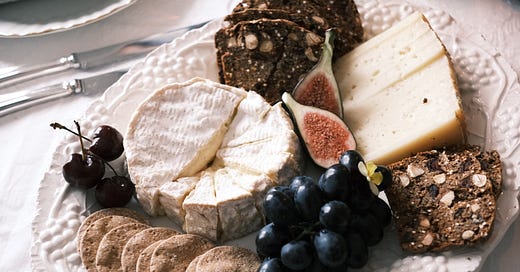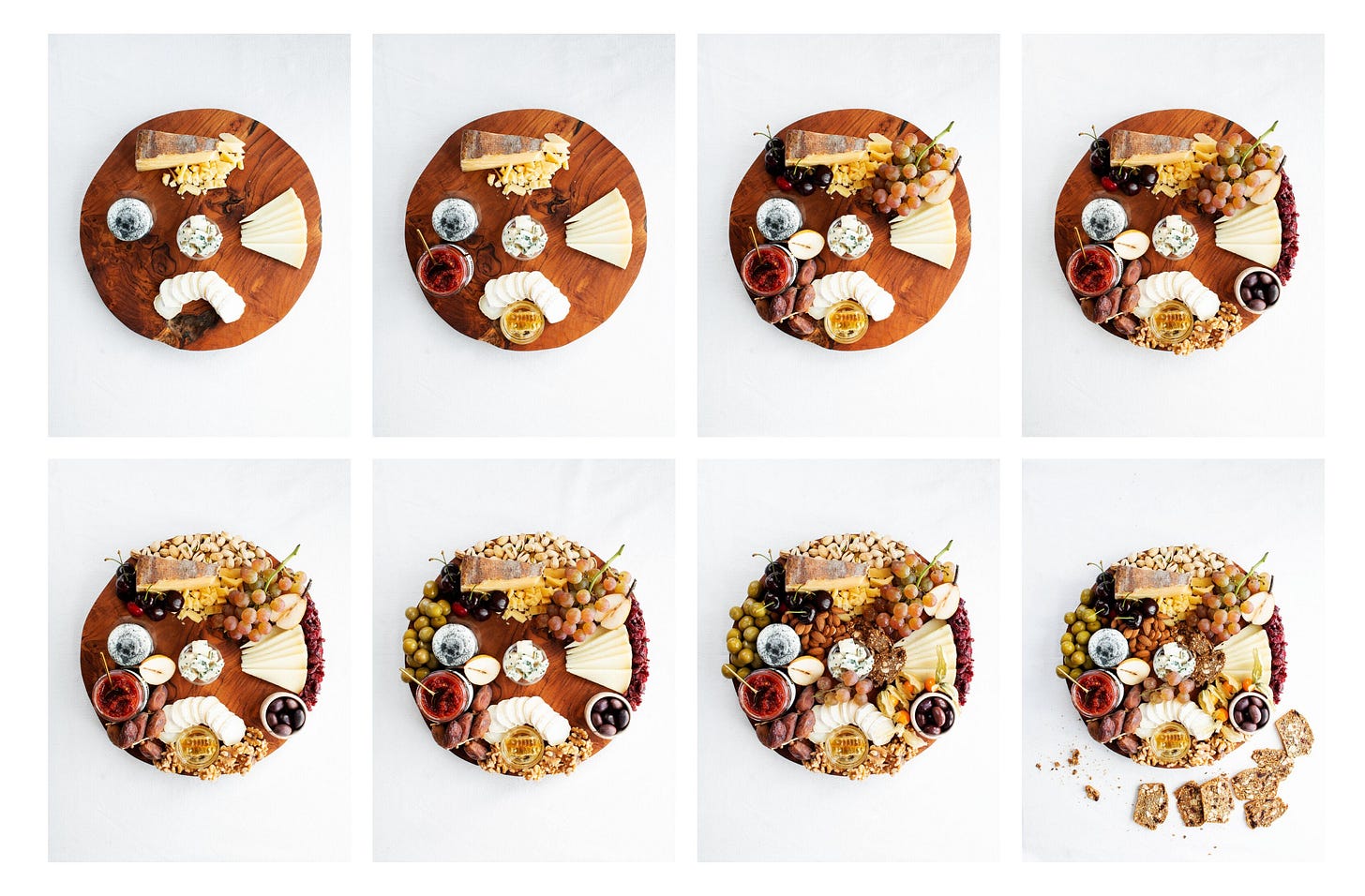Cheeseboards are a proper meal too, you know...?
What makes a good cheese, how cheese goes extinct (external read), and how to put together a quick cheeseboard.
I don’t think we collectively eat enough cheese, I said it. And I need to make a caveat here, by cheese I mean real artisanal cheese, not the mostly overprocessed kind you can find at most supermarkets. Cheese that you can easily find information on where it’s come from and who made it. Name and address. Preferably made with raw milk so it retains the good live bacteria and probiotics.
At face value, cheese is a great source of protein and fat, of course when eaten in moderation, like everything else. But it’s an even greater source of happiness and surely you can never have too much of that.
The science and experimentation behind it is what really does it for me. The fact that certain cheeses only exist out of sheer luck and that some of them will exist as long as their creator does because no one else knows the recipe. I love Ruby Tandoh’s article “How a Cheese Goes Extinct” in The New Yorker (2020). Give it a read, it’s beautifully written.
The flavour profiles achieved through the making and ageing of cheese are also a reason why I find it incredibly fascinating as a subject. Just like wine, there are hundreds of different flavours you can taste if you really tune in your senses. It’s an extraordinary experience.
Take, for example, Parmigiano Reggiano - often referred to as the King of Cheeses - with maturation times that range from 12, 24 and 36 months through to 40 and 100 months. A chunk of 12-month Parmigiano will show clear differences from a 36-month one, both in consistency and flavour. As the cheese loses moisture through the rind, the flavour intensifies and the texture becomes crumblier, showing more pockets of crystallisation throughout. The whole process involves incredible craft and knowledge from everyone involved but most importantly an undying love of cheese in its purest form.
What makes good cheese?
In a nutshell, cheese is only as good as the milk and the cheesemaker. Happy animals with a good quality and complete diet will produce the best possible milk, so it’s always in the cheesemaker’s best interest to take good care of them. It makes perfect sense.
Watch Jonny Crickmore from Fen Farm Dairy talk about what their herd of Montbeliarde cows eat. You can learn more about their lifestyle here.
More ways to eat cheese.
Ever heard of cheese ice cream? I’ve seen a few people pull some nasty faces when I’ve mentioned it and it’s ok, I won’t judge you. But for those of you who think this is the perfect excuse to eat even more cheese, let me introduce you to Madrid-based cheesemongers Formaje. Led by artisan cheesemongers Clara Diez and Adrián Pellejo, Formaje has been bringing back limited runs of their ‘Queso Helado’ (‘frozen cheese’) every summer since they launched in 2021. Past flavours included Stilton, Idiazabal, Queixo do País, Olavidia and Comté.
—
Let’s put a cheeseboard together, shall we?
What you’ll need:
1. Cheese
The perfect cheeseboard will feature a selection of different-style cheeses (goat, blue, soft, crumbly, hard) but it all depends on how many people you are serving and when it’s being served. This is where a good reliable cheesemonger comes in handy, they will be able to suggest options based on your preference, food allergies and occasion. Don’t be afraid to ask questions, your curiosity will be rewarded.
If served at the end of the meal, allow for around 80g per person, if it’s being served as the main meal you’ll need 100-150g of cheese per person.
Alex and Léo Guarneri write in their book “A Year of Cheese”:
“Preparing a good cheeseboard is all about balance, you need to think about balancing the taste and texture of the various cheeses. Try to have a soft, a hard and a blue cheese; then try to have different types of milk - cow, sheep and goat.”
I always like working with uneven numbers, 1, 3, 5, and so on. For example, if you are putting together a small cheeseboard for one or two people, you might want to select a maximum of three kinds of cheeses.
💡It’s better to buy bigger chunks of fewer kinds of cheese than multiple small pieces of many as they’ll keep better, should they not be consumed at once.
2. Savouries and Spreads
Butter, chutneys, honey, and savoury snacks help add dimension to your board. They can be paired and eaten with cheese or consumed on their own in between cheese courses. Always pick good quality products, ideally from smaller, independent businesses, they will make all the difference. Some of my favourites include:
Examples: Cornichons, Olives, Charcuterie, Raw Salted Butter, Chutneys, Honey, Relishes
3. Nuts, Fresh Fruits, Crackers and Bread
Nuts and fruits can help cut through the richness and creaminess of cheese. Fresh fruits like grapes and pears have a natural acidity that goes great with cheese. This is a great way to discover new flavour combinations and pad your board with plenty of extra snacks.
Examples:
Walnuts, Roasted Cashews, Pistachios, Roasted Marcona almonds
Fresh Fruit: Figs, Grapes, Blackberries, Pears, Cherries, Kumquats, Plums
Choosing a variety of crackers is your safest bet, but I always like to stick with a couple of options, a seeded cracker and my homemade rye-flaxseed crackers with nuts and dried cranberries. You may also want to include slices of baguette or lightly toasted sourdough bread, nothing goes better than bread and butter with cheese.
Need help getting started?
The Neal's Yard Dairy Subscription
Neal’s Yard Dairy have a fantastic monthly cheese subscription, featuring three different kinds of cheese every month with a minimum combined weight of 590g. The perfect way to try something new.
If you love Fen Farm Dairy’s Baron Bigod, this one’s for you. A quarterly cheese box featuring four guest cheeses plus a Baron Bigod, each box contains a combined minimum weight of 1kg. The subscription includes other great perks like a 20% members discount on the farm’s website.
—
Have I convinced to you eat more cheese? Do you have a favourite? Let me know in the comments and don’t forget to like and share this newsletter.






